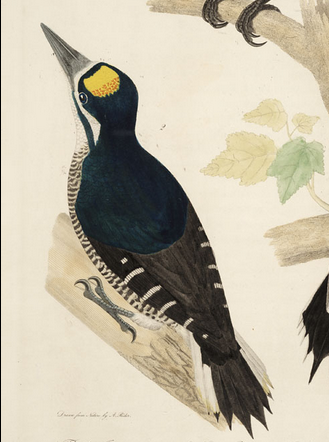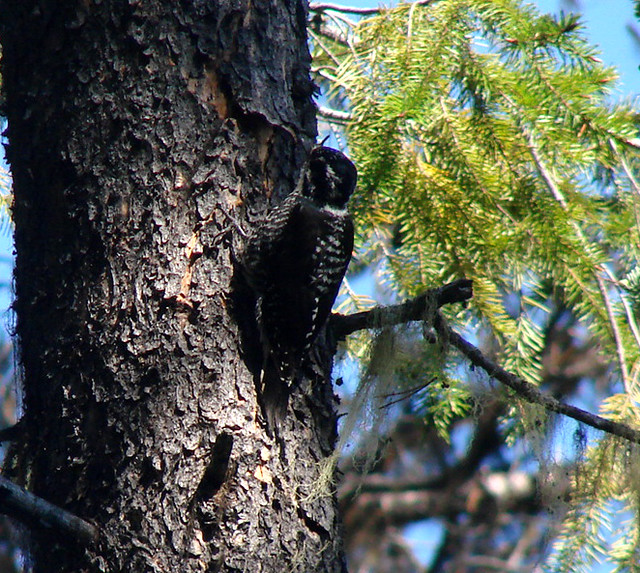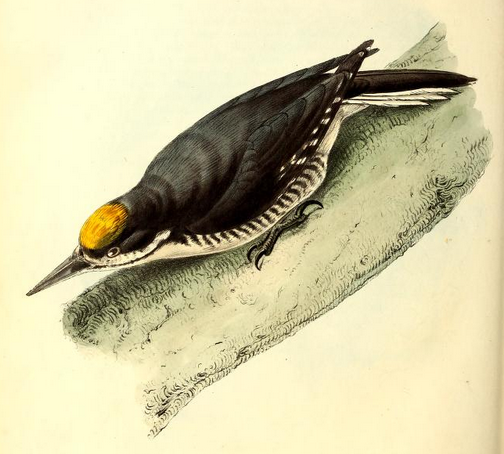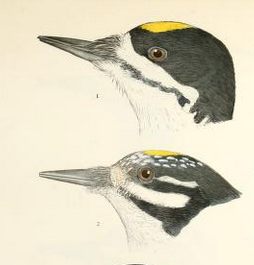Got a woodpecker question? Gerard Gorman’s new guide to the world’s picids is likely to answer it.
We weren’t so lucky back in 1828, when Alexander Rider produced the first painting of a black-backed woodpecker, for publication in Charles Bonaparte’s American Ornithology. To my eye, this is one of the most charming figures in the entire four-volume work, ornamental and informative all at once in spite of its classically Riderian stiffness.
But there’s more to this figure than mere prettiness. The story begins with Bonaparte’s caption:
That’s right: The prince of ornithology identifies this bird, which Rider painted from the “finest male specimen” in Bonaparte’s own collection, as the northern three-toed woodpecker, Picus Tridactylus.
Study of the accounts in other works convinced Bonaparte
that [this] species is subject to variations in size and plumage… thus, in some specimens the [nape] is described [as] white, or partly whitish, instead of being wholly black: the back is also said to be waved with white….
Those specimens, obviously, were of the “real” American three-toed woodpecker, even the darkest individuals of which differ from the black-backed in their white markings above. But Bonaparte, not recognizing that he had before him an undescribed species, analyzed the difference as one of age:
the young of both sexes are of a dull blackish… the feathers of the back being banded with white, giv[ing] to that part a waved appearance…
The logical result: America had but one species of six-toed woodpecker, adults of which had solid black backs and the young barred. Bonaparte was proud of having at last solved the puzzle:
we feel much gratification in being enabled to unveil to ornithologists the mystery of these diversities in this species, by merely pointing out the sexual differences, as well as those originating in the gradual change from youth to maturity….
With the benefit of 185 years of hindsight, of course, we know that Bonaparte was wrong. Not five years after the publication of the American Ornithology, William Swainson re-analyzed Bonaparte’s bird as a distinct species, the Arctic three-toed woodpecker.
In addition to what were now the obvious differences in plumage, the new woodpecker was “in every respect” larger than what Swainson called “the common species,” with a bill “considerably longer in proportion” and the wing more pointed in structure. Swainson’s formal description mentions Bonaparte only in the synonymy, but the paraliptic remark in the account of the American three-toed woodpecker must have stung:
it would be tedious, and it is perhaps unnecessary, to show in what manner all preceding ornithologists have confounded the northern three-toed Woodpeckers.
Indeed, even just after the publication of the Fauna boreali-americana, Audubon and Nuttall were still following Bonaparte’s classification.
Audubon did not recognize the two species as distinct until very late in the preparation of the Birds of America, noting in the final volume of the Ornithological Biography that he, like everyone else, had “looked upon” the bird we know as the American three-toed woodpecker “as the young of the species just mentioned,” namely, our black-backed woodpecker.
Nuttall, too, came around in the 1840 edition of his Manual, listing both species — the one glossy black above, the other “varied with black and white.”
Good to have all that settled.
Unfortunately, even after the true relationship of the two birds had been figured out, their English names continued to be a source of confusion for more than a century to come. In particular, the label “northern three-toed” has been applied at one time or another to each, and it is a relief — a more or less permanent one, I hope — that that name has been retired.
As if all this weren’t enough, there remains the question of Vieillot’s Picus hirsutus, cited by the older authorities as the original description of our American three-toed woodpecker. But that, thankfully, is another story, a story that will have to wait for another time.






